Sun Li-jen (traditional Chinese: 孫立人; simplified Chinese: 孙立人; pinyin: Sūn Lìrén) (December 8, 1900–November 19, 1990) was a Kuomintang (KMT) General, best known for his leadership in the Second Sino-Japanese War and the Chinese Civil War. His achievements earned him the laudatory nickname "Rommel of the East". His New 1st Army was reputed as the "1st [Best] Army under heaven" and credited with defeating the most Japanese troops. He was also known as Sun Chung-neng (孫仲能, Sūn Zhòngnéng) and had the courtesy name Sun Fu-min (孫撫民, Sūn Fǔmín).
Early life[]
Sun Li-jen was born in Jinnu, Lujiang, Chaohu, Anhui, with ancestry in Shucheng County. When his father was promoted to the governor of several districts in the Province of Shandong, Li-jen moved to Shandong with his father. China was curved in peril at that time and Chinese suffered from discrimination and prejudice. He was a victim of bullying by German boys and he made up his mind to make himself strong to earn respect and equality.
During the May Fourth Movement, he was part of the Scouts in the march at Tiananmen Square. In the same year (1919) he married Gong Xitao (龔夕濤) and was admitted in 1920 to Tsinghua University to study civil engineering. Sun played basketball at Tsinghua, becoming a star. He led the Chinese team to a gold medal at the 1921 Far Eastern Championship Games.
In the United States[]
With a Boxer Indemnity Scholarship, Sun was transferred to Purdue University in the United States to complete his senior year in 1923, where he graduated in 1924. But in the United States, ideological zeal motivated him to dramatically change vocations and pursue a military career instead. China was in the middle of civil war, and Soviet and Japanese invaders seemed poised to devour China. Sun decided that he could better serve his divided nation as a soldier rather than an engineer.
He applied to the Virginia Military Institute, also in the United States, lying about his age by four years so that he would appear young enough to meet the school's admissions requirements. He graduated from VMI in 1927 and joined the Nationalist Army's Finance Department headed by Minister T. V. Soong. During the Second Sino-Japanese War and the later Chinese Civil War in Northwest China, Sun Li-jen became a highly effective field officer and valued military general to the KMT.
Second Sino-Japanese War[]
Sun was a colonel and led his troops, a Tax Police Regiment, fighting Japanese during the Battle of Shanghai in 1937. He was badly wounded by mine fragments. After recovery from his injury, Sun led his troops back to the front line. Later, the Nationalist government formed National Salt Gabelle Brigade with 8 regiments. These were the KMT's best trained and equipped troops. Four of the regiments later became the New 38th Division, with Sun as the Commanding General. His training center was located in Duyun, in Guizhou province. After two years training, Sun's New 38th Division was part of the forces Chiang Kai-shek sent into Burma to protect the Burma Road under General Du Yuming.
Sun was unusually solicitous of his men. An American missionary doctor recalls Sun's "tall, handsome figure, looking much younger than his years, going round his wounded in the hospital wards, listening patiently, treating the enlisted men much more courteously than their sergeants or lieutenants would have done".This doubtless explains the unusually high morale and tactical ability of New 38 Division, evident even before it received American training at Ramgarh.
Battle of Yenangyaung[]
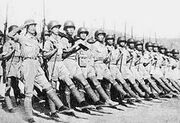
US equipped Chinese Army in India.

Parade of the Chinese 38th Division.
On 16 April 1942, almost 7,000 British soldiers, and 500 prisoners and civilians were encircled by an equal number of Japanese soldiers from the Japanese 33rd Division at Yenangyaung and its oil field. The 33rd Division had cut the Magwe road between Slim's two divisions, who were now about 50 miles (80 km) apart. The 1st Burma Division was hampered by large numbers of wounded men and short of water. Major General Bruce Scott, commanding the 1st Burma Division, telephoned General Sun Li Jen, commanding the Chinese 38th Division, asking for rescue soon after the 38th Division entered the area.
General Sun requested to lead his entire division to the rescue of 1st Burma Division, but General Lo Cho-ying, commanding the Chinese Expeditionary Force in Burma, refused. On 17 April, General Sun instead led his 113th Regiment with only 1121 men, of which only 800 were combat personnel, in the rescue mission. Because the Chinese had no artillery or tanks, Lieutenant General Slim assigned the 7th Armoured Brigade commanded by Brigadier John Henry Anstice to General Sun. The brigade consisted of two regiments (battalions) of M3 Stuart light tanks and a battery of 25-pounder guns.
For the next three days the Chinese attacked southwards. The temperatures reaches as high as 114 degrees Fahrenheit and pall of smoke from the demolished oil wells and refineries hung over the battlefield.
Meanwhile, 1st Burma Division fought its way to and across the Pin Chaung river where they met with the relief column on 19 April. On the next day, the Allied force attacked south toward Yenaungyaung and Pin Chaung. The attack caused the Japanese to suffer heavy casualties, but the Allied forces were too weak to hold the oil fields and had to retreat to the north.
The rescue mission had been a resounding success, but the 1st Burma Division had lost most of its heavy equipment and was exhausted and disorganised. Many of its Burmese troops had deserted. King George VI rewarded Sun Li Jen with the Commander of the Order of the British Empire, and honoured the Regiment Commander Colonel F.W. Liu and some other officers with medals.
Counter-offensive in Burma[]
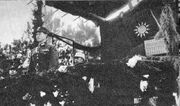
Oath-taking ceremony of Sun prior to movement to the front.
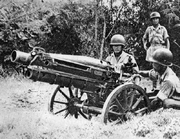
Chinese artillery.
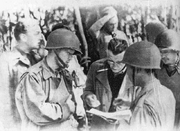
General Stillwell and Sun Li-jen
Sun's troops ultimately became a part of 'X Force', the Chinese forces under the command of Joseph Stilwell, the American commander of all American and Chinese forces deployed in the "China Burma India Theater". Sun's division, retrained and reequipped in India, solidified Stillwell's respect for the Chinese soldier, and ultimately spearheaded Stilwell's 1943 drive to reconquer North Burma and re-establish the land route to China by the Ledo Road.
In the spring of 1943, the High Command organized the New 38th Division, the New 22nd Division, and the newly created 30th Division (formed in India) into a new army - the New First Army. Lt. Gen. Cheng Tung-kuo was placed in command of the Army. General Sun Li-Jen served as the Deputy Commander, and commanded the New 38th Division concurrently, but he was the actual leader. As soon as the Burma Recapture mission started, General Sun became the Commander.
The New 30th Division was commanded by Maj. Gen. Hu Shu, while Maj. Gen. Liao Yao-hsiang retained the command of the New 22nd Division. Artillery regiments, Engineering regiments, motor transport regiments, armored car units, anti-aircraft units, signal corps, special service units, military police units, and men and animal transportation units, either sent from home or newly organized in India, increased the strength of the Army which was subsequently further augmented by the 14th and 50 Divisions after its march into the Hukawng Valley.
The counter-offensive in Burma began in March 1943, when the vanguards of the New 38th Division undertook the duty of annihilating or expelling the enemy on the Indian border so that the initial engineering work on the India-Burma Road could be protected. This prelude to the actual campaign was successfully completed ny the end of October, 1943, when the enemy's 18th Division, reputed a strong force, was driven away from its stronghold. The operations at this juncture were carried out under greatest difficulties, for in addition to the obstinate enemy, our forces had to combat the reptile infested jungle, where communications were entirely underdeveloped.
On the eve of New Year's Day of 1944, the New 38th Division successfully took Yupong Ga, and reinforcements arrived later. By February, 1944, the New 38th Division, continuing its success, occupied Taipha Ga, while the New 22nd Division also captured Taro, and the two forces launched a combined attack against Maingkwan. The victory at Walawbum on March 9 concluded the Hukawng Valley campaign.
The enemy defense of the Mogaung Valley was aided by its geographical advantages and Sun's progress was considerably checked by the difficult terrain. By the latter part of May, 1944, however, when a new strategy was employed Sun made his advance. In spite of the high water level on the river with the approach of the rainy season, Sun's troops succeeded in crossing the Namkawng River. This act surprised the enemy and cut off his retreat, capturing at the same time much of his supplies. The famous Battle of Seton ensued with disastrous results to the enemy. On June 16, Sun captured Kamaing, and on the 25th of the same month Mogaung also fell.
Simultaneous with this fighting in the Mogaung Valley, the fight for Myitkyina also raged high. A combined Chinese-American detachment, consisting of the New 38th Division, the 50th Division, and a portion of the 14th Division, with one regiment of American troops, attacked that important city. The Japanese staged a desperate defense and street fighting raged for 80 days. The city finally fell on August 4, and the first stage of the Burma counter-offensive was concluded.
During the temporary respite that followed this important victory, there were some changes in the organization and command of the Chinese Army in India. General Stilwell had been recalled to the United States and he was succeeded by Lt. Gen. Sultan, with Lt. Gen. Cheng Tung-kuo second-in-command. The Chinese Army in India was now composed of two armies - the New First and the New Sixth. The New First Army consisted of the New 30th Division and the New 38th Division. The New Sixth Army had under its command the 14th Division, the 50th Division, and the New 38th Division. Sun Li-jen commanded the New 1st Army while General Liao Yao-hsiang commanded the New 6th.
The rainy season of Burma ended by October when C.A.I. commenced its second phase of offensive. The New 6th Army except the 50th Division, which became part of the New First, had in the meantime been transferred to the home front and the New 1st Army continued its march towards Bhamo to complete the task of opening the overland road from India to China.
The siege of Bhamo reached its fiercest stage on November 17, 1944, when the Japanese resorted again to a desperate defense strategy. By December 15, enemy lines were fully penetrated, and the Chinese force pushing ahead passed Bhamo towards Namhkam. The Army was now met by the Japanese 49th Division, which had been specially transferred to Burma from Korea, only to be routed after five days of intensified combat.
Battle for Yupong Ga[]
At the start of the Burma offensive, the Chinese Army had encountered an enemy force five times its own strength, and there was encirclement and re-encirclement of each other during the whole Burma campaign. One battalion of the 112th Regiment was cut off from contact for 36 days, depending on supplies dropped by planes. Casualties suffered by both fighting parties were high.
On December 21, 1944, General Sun Li-jen personally led a rescue party and with courage and strategy completely routed a most obstinate enemy force, heralding other suvvesses that were to follow in the campaign. General Stilwell presented General Sun with a special pennant to commemorate this unprecedented victory.
In central Burma[]
Namhkam was entered by the New 30th Division on January 15, 1945. On January 27, the New 38th Division captured Mongyu, the junction between the new India Road and the former Burma Road. The following day, a ceremony was held to celebrate the junction of C.A.I. and Expeditionary Force from Yunnan, and Stilwell Road was fully opened.
To render effective assistance to the British allies fighting in lower Burma and to protect the newly opened Stilwell Road, the New First Army continued to push southward towards central Burma. On February 20, the New 30th Division captured Hsenwi, while on March 8, the New 38th Division captured Lashio. At the same time, the 50th Division, sweeping down from Katha, also captured in succession Mwanhawn, Namtu, and Hsipaw. On March 20, Kyankme was captured, completing the chain of victories of the Chinese Army in the Burma campaign.
The campaign in Burma occupied two full years, practically all of which were fully taken up in fighting against all odds. The difficult terrain and jungle fighting will all its horrors were strenuously overcome. All these factors made up an epic episode of achievement in our military annal.
During the campaign, Chinese Army encountered the Japanese 2nd, 18th, 49th, 53rd, and 56th Divisions and the 34th Independent Brigade, as well as other special units. The enemy suffered 33,082 dead, including many ranking officers, while another 75,000 casualties were counted as wounded, and more than 300 prisoners taken. The enemy practically suffered total annihilation. Chinese casualties were about one-sixth of that of the enemy. Trophies which were taken included 7,938 rifles, 643 machine guns, 185 cannons, 553 motor vehicles, 453 locomotives and wagons, 67 tanks, 5 airplanes, 108 godowns, and more than 20,000 tons of metals. The area liberated cy C.A.I. was more than 50,000 square miles, in which were 646 miles of highways and 161 miles of railroads.
In Taiwan[]
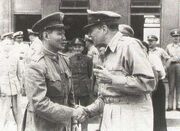
1950, Gen. Sun Li-jen met Gen. Douglas MacArthur.
As the commander of the Army Training Command and deputy commander of the Republic of China Army in 1947, Sun moved one training facility to Taiwan, independent from the on-going civil war. Sun trained new officers and troops for the Nationalist government, hoping to change the tide of the civil war. The effort was too little, too late in comparison with the massive numbers of troops defeated, but one of the divisions he trained (201 Division of the 80th Army) was sent to Quemoy to help fend off the communist invasion in 1949. It was the front line defense force.
On February 11, 1949, General Douglas MacArthur sent a special envoy led by a major general to Taiwan. He invited General Sun to Tokyo for a talk. Sun did not immediately accept the invitation. He asked for permission of Chiang Kai Shek, through Chen Cheng, Chiang's right-hand man and governer of the Southeast China at that time. After Chiang agreed, Sun flew to Japan in MacArthur's private jet.
MacArthur told Sun that the United States would like Sun to assume the responsibility of safeguarding Taiwan. The American would give him full support, be it money or arms. Gen. Sun suggests that he would back Chiang in defending Taiwan. When he returned to Taiwan, he briefed Chen Cheng on his talk with MacArthur and asked Chen to tell Chiang.
Later in 1950, Sun was named the Commander in Chief of the Republic of China Army, while also serving as commander of the Taiwan Defense Command and the Army Training Command. Because Sun was well respected by the Americans and rumors had it that the Americans would like to help him into power to replace Chiang Kai-Shek, Chiang and his son Chiang Ching-kuo were eager to remove him from power.
First, Sun was reassigned as the ceremonial chief military adviser to Chiang Kai-Shek in June 1954, preventing him from directly controlling any troops. In 1950, Chiang's son became director of his father's secret police, a position he held until 1965. The son, educated in the Soviet Union, initiated Soviet style military organization in the Republic of China military, reorganizing and Sovietizing the officer corps, instituting surveillance. Opposed to this was Sun Li-jen, who was educated at the American Virginia Military Institute. Chiang's son orchestrated the controversial arrest and court-martial of Sun in August 1955, allegedly for plotting a coup d'état with the American CIA against his father. The CIA allegedly wanted to help Sun take control of Taiwan and declare its independence. Sun remained under house arrest until much later he was released on March 20, 1988, shortly after the death of Chiang Ching-kuo.
Sun died in his Taichung home at the age of 89 (91 according to the Chinese calendar). His funeral was attended with full military honors and with the presence of the Secretary of Defense. His reputation was cleared in 2001 after a government investigation into the purported coup attempt. In January 2011, President Ma Ying-jeou formally apologized to Sun Li-jen's family and Sun's house in Taichung was opened as a memorial hall and museum. General Sun is survived by his two sons Sun Tien-ping (孫天平) and Sun An-ping (孫安平), daughters Sun Chung-ping (孫中平)and Sun Tai-ping (孫太平), and sister Sun Pi-jen (孫璧人).
